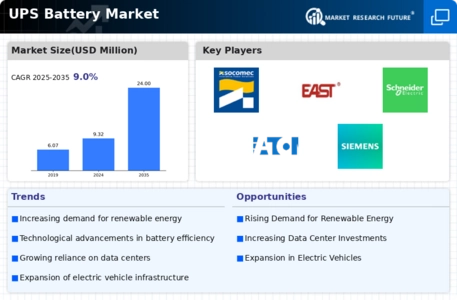The UPS Battery Market is characterized by a dynamic competitive landscape, driven by increasing demand for reliable power solutions across various sectors, including data centers, healthcare, and telecommunications. Key players such as Schneider Electric (FR), Eaton (US), and Vertiv (US) are strategically positioned to leverage innovation and technological advancements. Schneider Electric (FR) focuses on sustainability and digital transformation, aiming to enhance energy efficiency in its UPS solutions. Eaton (US) emphasizes its commitment to smart power management, while Vertiv (US) is dedicated to providing critical infrastructure solutions, particularly in the data center segment. Collectively, these strategies foster a competitive environment that prioritizes technological innovation and customer-centric solutions.
In terms of business tactics, companies are increasingly localizing manufacturing and optimizing supply chains to enhance operational efficiency. The market structure appears moderately fragmented, with several key players exerting influence over their respective segments. This fragmentation allows for a diverse range of offerings, catering to various customer needs while fostering healthy competition among established and emerging players.
In November 2025, Schneider Electric (FR) announced a partnership with a leading cloud service provider to integrate its UPS systems with advanced AI capabilities. This strategic move is expected to enhance predictive maintenance and energy management, positioning Schneider Electric as a frontrunner in the digital transformation of power solutions. The integration of AI into UPS systems could significantly improve operational reliability and reduce downtime for critical applications.
In October 2025, Eaton (US) launched a new line of modular UPS systems designed for scalability and efficiency. This product line aims to address the growing demand for flexible power solutions in data centers and industrial applications. By focusing on modularity, Eaton is likely to attract customers seeking customizable solutions that can adapt to changing power requirements, thereby reinforcing its market position.
In September 2025, Vertiv (US) expanded its manufacturing capabilities in Asia to meet the rising demand for UPS systems in the region. This expansion not only enhances Vertiv's production capacity but also reduces lead times for customers, which is crucial in a market where rapid deployment is often necessary. Such strategic moves indicate Vertiv's commitment to strengthening its supply chain and improving service delivery in a competitive landscape.
As of December 2025, current trends in the UPS Battery Market are heavily influenced by digitalization, sustainability, and the integration of AI technologies. Strategic alliances among key players are shaping the competitive landscape, fostering innovation and enhancing product offerings. The shift from price-based competition to a focus on technological advancement and supply chain reliability is evident. Companies that prioritize innovation and sustainability are likely to differentiate themselves in an increasingly competitive market, suggesting a future where technological prowess and operational excellence become the primary drivers of success.

















Leave a Comment